Related Research Articles
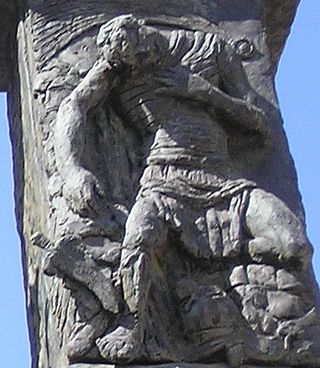
The Bar Kokhba revolt was a large-scale armed rebellion initiated by the Jews of Judea, led by Simon bar Kokhba, against the Roman Empire in 132 CE. Lasting until 135 or early 136, it was the third and final escalation of the Jewish–Roman wars. Like the First Jewish–Roman War and the Second Jewish–Roman War, the Bar Kokhba revolt resulted in a total Jewish defeat; Bar Kokhba himself was killed by Roman troops at Betar in 135 and the Jewish rebels who remained after his death were all killed or enslaved within the next year.

Usha was an ancient Jewish town in the western part of Galilee. It was identified in the late 19th century by Victor Guérin, who found the ruins on which the Arab village of Hawsha was built.
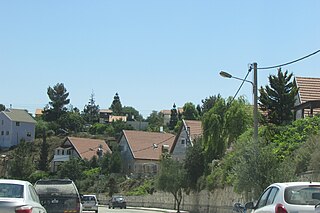
Ma'ale Levona is an Israeli settlement organized as a community settlement in the West Bank. Located to the south-east of Ariel, it falls under the jurisdiction of Mateh Binyamin Regional Council. In 2022, it had a population of 1,018.
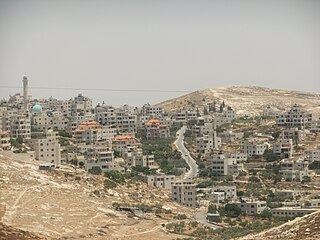
Mukhmas is a Palestinian village in the Jerusalem Governorate, located northeast of Jerusalem, in the center of the West Bank. According to the Palestinian Central Bureau of Statistics, the town had a population of 1,363 in 2017.

Kfar HaOranim, also known as Menora or Giv'at Ehud, is an Israeli settlement in the West Bank. Contiguous with Lapid and located near to the major city of Modi'in, it is organised as a community settlement and falls under the jurisdiction of Mateh Binyamin Regional Council. In 2022 it had a population of 2,604.

The Second Temple period or post-exilic period in Jewish history denotes the approximately 600 years during which the Second Temple stood in the city of Jerusalem. It began with the return to Zion and subsequent reconstruction of the Temple in Jerusalem, and ended with the First Jewish–Roman War and the Roman siege of Jerusalem.

Horvat Burgin, or Burgin, is an archaeological site in the Judaean Lowlands. Settlement at the site began in the Iron Age. During the Second Temple period, it was a Jewish settlement, which was abandoned in the aftermath of the Bar Kokhba revolt. In the Byzantine period it was populated by Christians, likely including Georgian monks. In the modern period, it was a small Arab hamlet named Khirbat Umm Burj, which was depopulated in 1948.

Adullam Grove Nature Reserve is a nature reserve in central Israel, south of Beit Shemesh, managed by the Israel Nature and National Parks Protection Authority.
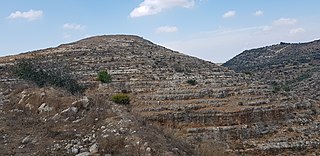
Khirbet Tibnah, is located on the West Bank, between the villages Deir Nidham and Nabi Salih.

Horvat 'Ethri, Hebrew for "Ethri ruin", Arabic name: Umm Suweid, is an archaeological site situated in the Judean Lowlands in modern-day Israel. Excavations at the site uncovered the remains of a now partially restored Jewish village of the Second Temple period, wherein are preserved an ancient synagogue, wine presses, cisterns, ritual baths and stone ossuaries, as well as an underground hideout system. The village was violently destroyed during the Bar Kokhba revolt.

Khirbet Kurkush is an archeological site in the West Bank. It lies between the Israeli settlements of Bruchin and Ariel and near the Palestinian town of Bruqin, in the Salfit Governorate of the State of Palestine.
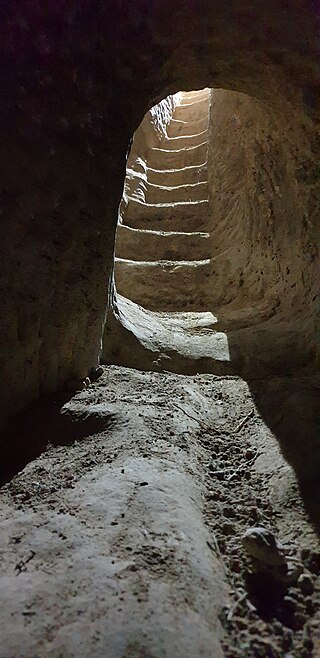
The Bar Kokhba hiding complexes are underground hideout systems built by Jewish rebels and their communities in Judaea and used during the Bar Kokhba revolt against the Roman Empire. The hiding complexes are believed to have played a significant role during the revolt, particularly in Judea proper. Functioning as hiding places during times of emergency, these systems facilitated defense strategies and guerrilla warfare tactics.

The Bar Kokhba refuge caves are natural caves used for shelter by Jewish refugees during the later phases of the Bar Kokhba revolt. Most of the refuge caves were located in the Judaean Desert, nestled within steep cliffs far away from settlements, many overlooking the Dead Sea and the Jordan Valley. Some were also found in ravines flowing into the Dead Sea, while others were nestled within the Judaean Mountains. Unlike the other two hideout systems used by the rebels, the man-made rock-cut hiding complexes, and the hard-to-reach cliff shelters which often contain hewn installations, the refuge caves remained largely untouched by human intervention.
The 'Beersheba settlement' is an ancient Jewish site in the Negev Desert.

Artabba Fortress is a Hasmonean-Herodian fortress, discovered in 2015 by Dvir Raviv from Bar-Ilan University and Aharon Tavger from Ariel University. The site is located at the top of a hill at a height of 364 meters, is near the ravine of Wadi Artabba, also known as Nahal Natuf, southeast of the Palestinian village of Deir Abu Mash'al in the West Bank.

Khirbet el-ʻAqd or Horvat ʻEqed is an archaeological site in the Latrun salient of the West Bank, approximately 22 km northwest of Jerusalem. The site, situated on a hill, contains the ruins of an ancient fortified town dating from the Hellenistic period through the Bar Kokhba revolt, after which the site was ultimately abandoned.
The archaeological survey of Judea and Samaria and the Golan in 1968 or as it was called the "Emergency Survey" is the first comprehensive archaeological survey that was conducted in these areas.

Deir ed Derb is a monumental Jewish tomb with an elaborate façade dated to the 1st century CE. The site is located in the West Bank about 1/2-mile SE of the village center of Qarwat Bani Hassan. Its Arab name derives from the ancient road passing near it and refers to a monastery.

Khirbet el-Qutt is an ancient Jewish archeological site. It is located about a km north of the Israeli settlement of Ma'ale Levona in the West Bank. It was inhabited from the early Bronze Age to the early Muslim period. It was a fortified Jewish village from at least the end of the Second Temple period to the Bar Kokhba revolt.
Kiryat Arbaya is an ancient settlement mentioned in two letters written by Simon Bar Kokhba, discovered in the Cave of Letters in Nahal Hever. The settlement has been proposed to be identified with the Arab village of Al-Arroub south of Gush Etzion or with Khirbet Arbaya nearby, close to the road between Bethlehem and Hebron. This area is located between Ein Gedi and Betar, where Bar Kokhba's main camp was likely situated. The literal meaning of the name is 'City of the Arabs' or – what might be more plausible in light of the letter's content – 'City of the Willows'. Additionally, some have suggested identifying Kiryat Arbaya from Bar Kokhba's letters with the legend of the birth of the Messiah that appears in the Jerusalem Talmud and in Lamentations Rabbah.
References
- 1 2 3 4 5 6 7 8 9 Raviv, Dvir. "Raviv D., 2016, "Khirbet Kelafa – A Jewish settlement from the Second Temple period and the Bar-Kokhba Revolt in the Northern Hebron Mountains", In the Highland's Depth - Ephraim Range and Binyamin Research Studies, Vol. 6, Ariel-Talmon, pp. 51*-66*". Academia.
- ↑ רביב, דביר; הר-אבן, בנימין; טבגר, אהרן (2016). "חורבת אל-קט – כפר יהודי מבוצר משלהי ימי הבית השני ועד מרד בר-כוכבא בדרום השומרון". במעבה ההר. 6: 107–128. ISSN 2521-9456.
- ↑ "Volume 122 Year 2010 Umm el-'Amad (West)". www.hadashot-esi.org.il. Retrieved 2024-06-16.